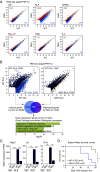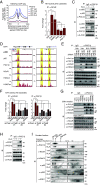A TLR4/TRAF6-dependent signaling pathway mediates NCoR coactivator complex formation for inflammatory gene activation
- PMID: 38165941
- PMCID: PMC10786282
- DOI: 10.1073/pnas.2316104121
A TLR4/TRAF6-dependent signaling pathway mediates NCoR coactivator complex formation for inflammatory gene activation
Abstract
The nuclear receptor corepressor (NCoR) forms a complex with histone deacetylase 3 (HDAC3) that mediates repressive functions of unliganded nuclear receptors and other transcriptional repressors by deacetylation of histone substrates. Recent studies provide evidence that NCoR/HDAC3 complexes can also exert coactivator functions in brown adipocytes by deacetylating and activating PPARγ coactivator 1α (PGC1α) and that signaling via receptor activator of nuclear factor kappa-B (RANK) promotes the formation of a stable NCoR/HDAC3/PGC1β complex that coactivates nuclear factor kappa-B (NFκB)- and activator protein 1 (AP-1)-dependent genes required for osteoclast differentiation. Here, we demonstrate that activation of Toll-like receptor (TLR) 4, but not TLR3, the interleukin 4 (IL4) receptor nor the Type I interferon receptor, also promotes assembly of an NCoR/HDAC3/PGC1β coactivator complex. Receptor-specific utilization of TNF receptor-associated factor 6 (TRAF6) and downstream activation of extracellular signal-regulated kinase 1 (ERK1) and TANK-binding kinase 1 (TBK1) accounts for the common ability of RANK and TLR4 to drive assembly of an NCoR/HDAC3/PGC1β complex in macrophages. ERK1, the p65 component of NFκB, and the p300 histone acetyltransferase (HAT) are also components of the induced complex and are associated with local histone acetylation and transcriptional activation of TLR4-dependent enhancers and promoters. These observations identify a TLR4/TRAF6-dependent signaling pathway that converts NCoR from a corepressor of nuclear receptors to a coactivator of NFκB and AP-1 that may be relevant to functions of NCoR in other developmental and homeostatic processes.
Keywords: NCoR; PGC1β; TLR4; TRAF6; macrophage.
Conflict of interest statement
Competing interests statement:C.K.G. is a cofounder, equity holder and member of the Scientific Advisory Board of Asteroid Therapeutics.
Figures







Similar articles
-
RANK ligand converts the NCoR/HDAC3 co-repressor to a PGC1β- and RNA-dependent co-activator of osteoclast gene expression.Mol Cell. 2023 Oct 5;83(19):3421-3437.e11. doi: 10.1016/j.molcel.2023.08.029. Epub 2023 Sep 25. Mol Cell. 2023. PMID: 37751740 Free PMC article.
-
A nuclear receptor corepressor transcriptional checkpoint controlling activator protein 1-dependent gene networks required for macrophage activation.Proc Natl Acad Sci U S A. 2004 Oct 5;101(40):14461-6. doi: 10.1073/pnas.0405786101. Epub 2004 Sep 27. Proc Natl Acad Sci U S A. 2004. PMID: 15452344 Free PMC article.
-
MyD88 adapter-like (Mal)/TIRAP interaction with TRAF6 is critical for TLR2- and TLR4-mediated NF-kappaB proinflammatory responses.J Biol Chem. 2009 Sep 4;284(36):24192-203. doi: 10.1074/jbc.M109.023044. Epub 2009 Jul 10. J Biol Chem. 2009. PMID: 19592497 Free PMC article.
-
Genetic and Epigenetic Regulation of the Innate Immune Response to Gout.Immunol Invest. 2023 Apr;52(3):364-397. doi: 10.1080/08820139.2023.2168554. Epub 2023 Feb 6. Immunol Invest. 2023. PMID: 36745138 Review.
-
Toll-Like Receptor 4 (TLR4)/Opioid Receptor Pathway Crosstalk and Impact on Opioid Analgesia, Immune Function, and Gastrointestinal Motility.Front Immunol. 2020 Jul 8;11:1455. doi: 10.3389/fimmu.2020.01455. eCollection 2020. Front Immunol. 2020. PMID: 32733481 Free PMC article. Review.
Cited by
-
Toll-Like Receptors in the Immunotherapy Era: Dual-Edged Swords of Tumor Immunity and Clinical Translation.MedComm (2020). 2025 Jul 27;6(8):e70308. doi: 10.1002/mco2.70308. eCollection 2025 Aug. MedComm (2020). 2025. PMID: 40727252 Free PMC article. Review.
-
Nuclear receptors in health and disease: signaling pathways, biological functions and pharmaceutical interventions.Signal Transduct Target Ther. 2025 Jul 28;10(1):228. doi: 10.1038/s41392-025-02270-3. Signal Transduct Target Ther. 2025. PMID: 40717128 Free PMC article. Review.
-
Tricarboxylic Acid Cycle Regulation of Metabolic Program, Redox System, and Epigenetic Remodeling for Bone Health and Disease.Antioxidants (Basel). 2024 Apr 17;13(4):470. doi: 10.3390/antiox13040470. Antioxidants (Basel). 2024. PMID: 38671918 Free PMC article. Review.
-
Functional inversion of circadian regulator REV-ERBα leads to tumorigenic gene reprogramming.Proc Natl Acad Sci U S A. 2024 Oct 15;121(42):e2411321121. doi: 10.1073/pnas.2411321121. Epub 2024 Oct 9. Proc Natl Acad Sci U S A. 2024. PMID: 39383000 Free PMC article.
-
Downregulation of the NF-κB protein p65 is a shared phenotype among most anti-aging interventions.Geroscience. 2025 Jun;47(3):3077-3094. doi: 10.1007/s11357-024-01466-9. Epub 2024 Dec 12. Geroscience. 2025. PMID: 39666139 Free PMC article.
References
-
- Perissi V., Jepsen K., Glass C. K., Rosenfeld M. G., Deconstructing repression: Evolving models of co-repressor action. Nat. Rev. Genet 11, 109–123 (2010). - PubMed
-
- Hu X., Li S., Wu J., Xia C., Lala D. S., Liver X receptors interact with corepressors to regulate gene expression. Mol. Endocrinol. 17, 1019–1026 (2003). - PubMed
MeSH terms
Substances
Grants and funding
LinkOut - more resources
Full Text Sources
Molecular Biology Databases
Research Materials
Miscellaneous

